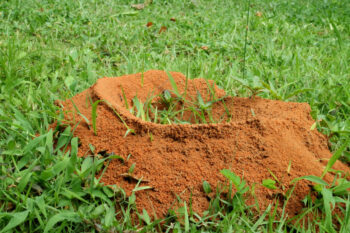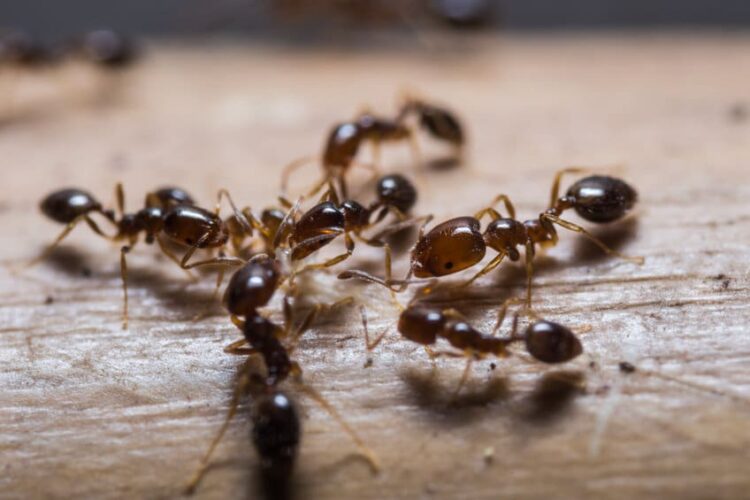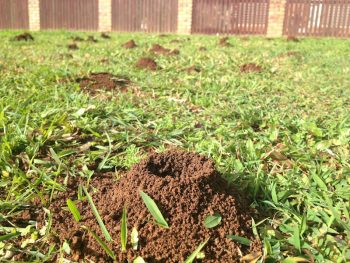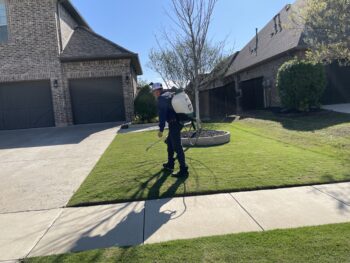 Fire ants are common lawn pests. They will invade every lawn at one point or another.
Fire ants are common lawn pests. They will invade every lawn at one point or another.
Newly mated fire ant queens will quickly colonize your yard. Spring and fall are the times of the year when fire ants usually mate and reproduce.
Also, new fire ant colonies seek out areas devoid of other colonies. When you see a mound, there could already be up to 50,000 ants underground. Once a mound appears, it means that the ants have been colonizing underground for months.
Thus, keeping your lawn and landscape fire ant-free is a never-ending battle. Luckily, there are many budget-friendly options available.
This article will discuss the following methods of fire ant prevention:
- Broadcast Baits
- Individual Mound Treatments
- Two-Step Treatment
- Long Residual Contact Insecticide Treatments
Broadcast Baits
An inexpensive and effective way to deter fire ants is to use baits. Proper baiting techniques can reduce mounds in your yard by up to 80-90%.
These work because the worker ants take the bait home and share it with the queen. Broadcast baits work slowly, over a period of 3-4 weeks.
Some recommended baits are Amdro, Siege, Logic, Award, Ascend, or Raid Fire Ant Killer.
It is more effective to treat a large area at once rather than constantly treating individual mounds. Spot treating fire ants will never completely work because aside from the large piles, there are numerous small colonies growing all the time.
If only the largest mounds are removed, the smaller colonies will thrive with less competition. Broadcast bait treatments target all colonies in the yard, regardless of size.
Due to active foraging, early spring is a good time to apply fire ant baits to prevent infestations. If you live in a rural area with many fire ants, treating twice a year can help. In cities, you may only need to treat annually.
Remember that broadcast baits work slowly. These workers return activated bait granules to the colony. To eat solid food, adults must feed it to their larvae. The insecticide-laced food will eventually kill the queen.
A hand-powered spreader can apply fire ant baits to lawns or gardens. Read the directions carefully and follow guidelines accordingly.
Individual Mound Treatments
Individual mound treatments can be timely and costly depending on the number of mounds you have. Think about it as $2 per mound. In a smaller yard, the price may be affordable, but for a large yard or field, it can get expensive.
There are chemical and organic options available.
One chemical option is dust products, which work quickly and do not require water. They do leave behind a residue though. Liquid drenches are another chemical method. They do not leave any residue and they work in just a few hours. Granular products also contain chemicals. These are fast-acting. Simply spread the granules on top of the mound and add water.
The most popular organic option is to pour boiling water on top of the mound. This will usually kill the ants, but the hot water will also kill any grass or plants that it comes in contact with. There are a few organic insecticides on the market as well.
Two-Step Treatment
The two-step treatment is one of the most popular methods of fire ant prevention and elimination. Apply a broadcast bait across your whole yard anytime from the end of August through mid-October. In some cases, homeowners may need to set the broadcast bait twice a year.
There are fast-acting and slow-acting broadcast baits. Liquid or granular pesticides can be sprayed or spread over an area.
Anytime after that when an individual mound pops up, treat with a mound drench, granule, bait, or dust pesticide. This is the most cost-effective way to treat fire ants.
Long Residual Contact Insecticide Treatments
This method is costly but successful. The ants will try to move and everywhere they go, they are met with the poison.
Use a push-type spreader to apply this granular product. Water your lawn and landscape very well after. This method is so effective, you will only need to do it once a year.
Final Thoughts
Fire ants were accidentally imported into the United States sometime in the 1930s from South America. They have been reproducing and spreading ever since.
Currently, it is not possible to completely eliminate fire ants. The good news is that it is possible to control and temporarily remove them.
In order to do this, you need to be proactive and prepared. Look over the treatment options in this article and decide which method best fits your budget and your problem. Spring is coming, start getting your lawn ready today.






